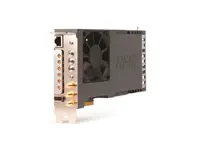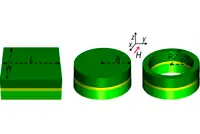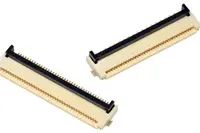Electronics News
Archive : 16 September 2015 год
 RFEL has announced qu-IQ, a flexible, resource rich development platform for demanding signal processing applications. With a Xilinx Kintex 7 FPGA, a Xilinx Zynq 7045 SoChip and 3Gbyte of on board DDR3 memory, the platform is housed on a PCIe 2.0 host card.The qu-IQ features 750k logic cells and nearly 2500 DSP48 slices, which provides a resource for the development and proving of modern signal processing applications.
RFEL has announced qu-IQ, a flexible, resource rich development platform for demanding signal processing applications. With a Xilinx Kintex 7 FPGA, a Xilinx Zynq 7045 SoChip and 3Gbyte of on board DDR3 memory, the platform is housed on a PCIe 2.0 host card.The qu-IQ features 750k logic cells and nearly 2500 DSP48 slices, which provides a resource for the development and proving of modern signal processing applications.
The device comes with an evaluation version of RFEL’s ChannelCore Flex IP core that provides rapid wideband channelisation out of the box, with 128 channels with real-time programmable response frequency, bandwidth and channel response as well as a powerful fractional rate resampler on each channel.
Dr Alex Kuhrt, RFEL’s CEO, said: “We have drawn on all our years of expertise on creating state of the art, digital signal processing solutions on FPGAs to design this open development platform for prototyping and algorithm development, which is also targeted at hardware-in-loop testing.This will enable customers to reduce their time to market and de-risk complex DSP development programmes for defence, security, military and industrial applications.”
A PCIe Gen2x8 interface enables DMA data transfers at up to 24Gbit/s to and from a host PC. Additional off-board connectivity and control is via Gigabit Ethernet and USB 2.0.
Author
Graham Pitcher
Source: www.newelectronics.co.uk
 A €7.3million pan European project involving industry, research institutes and universities from four countries will evaluate the infrastructure required for next generation communications networks and services.
A €7.3million pan European project involving industry, research institutes and universities from four countries will evaluate the infrastructure required for next generation communications networks and services.
According to the project – called 5G XHaul – its goal is to find solutions to the growing demand for broadband. It will have a particular focus on establishing dynamically adaptive communication for transport hubs and at major events.
5G XHaul – part of the 5G Infrastructure Public Private Partnership (5G-PPP) – will be co-ordinated by Innovations for High Performance Microelectronics (IHP).Dr Eckhard Grass from IHP said: “5G-XHaul will help to ensure that every smart phone owner can rely on an uninterrupted network connection with a high data rate.” Initially, the project is proposing a converged optical and wireless network solution that can connect small cells to the core network flexibly. “Exploiting user mobility,” Dr Grass continued, “our solution allows the dynamic allocation of network resources to predicted and actual hotspots.”
Field trials are already underway, including the Open project in Bristol, where Blu Wireless Technology is trialling the use of its 60GHz modules to provide wireless backhaul. Mark Barrett, CMO of Blu Wireless Technology, said of the project, “XHaul is an exciting collaboration set up to establish the ways that networks of the future will operate. For Bristol is Open, Blu Wireless is deploying its mm wave technology to extend the fibre network.Millimetre wave wireless technology will form a key aspect of 5G and we are very pleased to be involved with this important project”.
Author
Graham Pitcher
Source: www.newelectronics.co.uk
 Researchers at the Italian National Research Council (SPIN-CNR) and the Italian National Enterprise for nanoScience and nanoTechnology (NEST-CNR) claim to have devised an inexpensive way to turn low frequency signals into higher frequencies.
Researchers at the Italian National Research Council (SPIN-CNR) and the Italian National Enterprise for nanoScience and nanoTechnology (NEST-CNR) claim to have devised an inexpensive way to turn low frequency signals into higher frequencies.
The approach makes use of a Josephson junction, currently used to make extremely sensitive voltmeters and to detect minute changes in magnetic fields.
Josephson junctions consist of a thin layer of insulator sandwiched between two superconducting layers. Under the right conditions, electrons travel from one superconducting layer to the other with no resistance through the insulator in the middle. When the current reaches a critical level, a finite resistance appears and a voltage develops across the device.
Paolo Solinas, a physicist at SPIN-CNR, was experimenting on Josephson junctions with his colleagues at NEST-CNR, when unusual behaviour was seen. The team found that Josephson junctions placed in an oscillating magnetic field produced voltage pulses.
Turning to theory, the researchers found that an oscillating magnetic field produced a ‘phase’ – a sudden jump in a quantum mechanical property of the superconductor layers. The phase jump in turn produced the voltage pulse. The researchers also found that a regularly time-dependent magnetic field would produce voltage pulses that contained hundreds of harmonics of the original driving frequency, including frequencies thousands of times higher.
“The output of a single device is small,” said Solinas, “but you could build an array of devices to turn the intrinsic low power of a single junction into higher output power.” The team calculated that, by stringing together 1000 Josephson junctions made from niobium and aluminum oxide, a 100MHz input frequency could be converted into a 100pW signal at 50GHz.
The team also found that changing the shape of the Josephson junction changed the amount of power at different output frequencies. In particular, a ring shaped junction produced more power at higher harmonics than a circular or rectangular junction.
According to Solinas, electronic circuits made from Josephson junctions could be millimetres long and be readily integrated into chips.
Author
Graham Pitcher
Source: www.newelectronics.co.uk
Hitaltech has been appointed as an authorised distributor for Omron Electronic Components. As part of the deal, Hitaltech will offer Omron’s range of FPC-FFC connectors, including the XF3M, pictured, said to be ideal for applications requiring a connection between an LCD panel and a PCB or for other board to board connections.
 “We are focused on design-in applications, working with engineers to offer solutions for their design requirements,” said Hitaltech managing director Andrew Fitzer. “The inclusion of Omron’s FFC-FPC connector range is synergetic with our existing range of products, allowing us to now offer our customers a connector which is compatible with our flexible cables.”
“We are focused on design-in applications, working with engineers to offer solutions for their design requirements,” said Hitaltech managing director Andrew Fitzer. “The inclusion of Omron’s FFC-FPC connector range is synergetic with our existing range of products, allowing us to now offer our customers a connector which is compatible with our flexible cables.”
The FFC-FPC connector has a height of 2mm and a depth of 6.4mm when locked. A dual contact structure enable the cable to be inserted either way up and, to simplify insertion, the connector can accept cable inserted at an angle and then lock securely. It accepts 0.3mm thick FPC or FFC cable and is available in 0.5mm and 1mm pitches.
Author
Graham Pitcher
Source: www.newelectronics.co.uk

